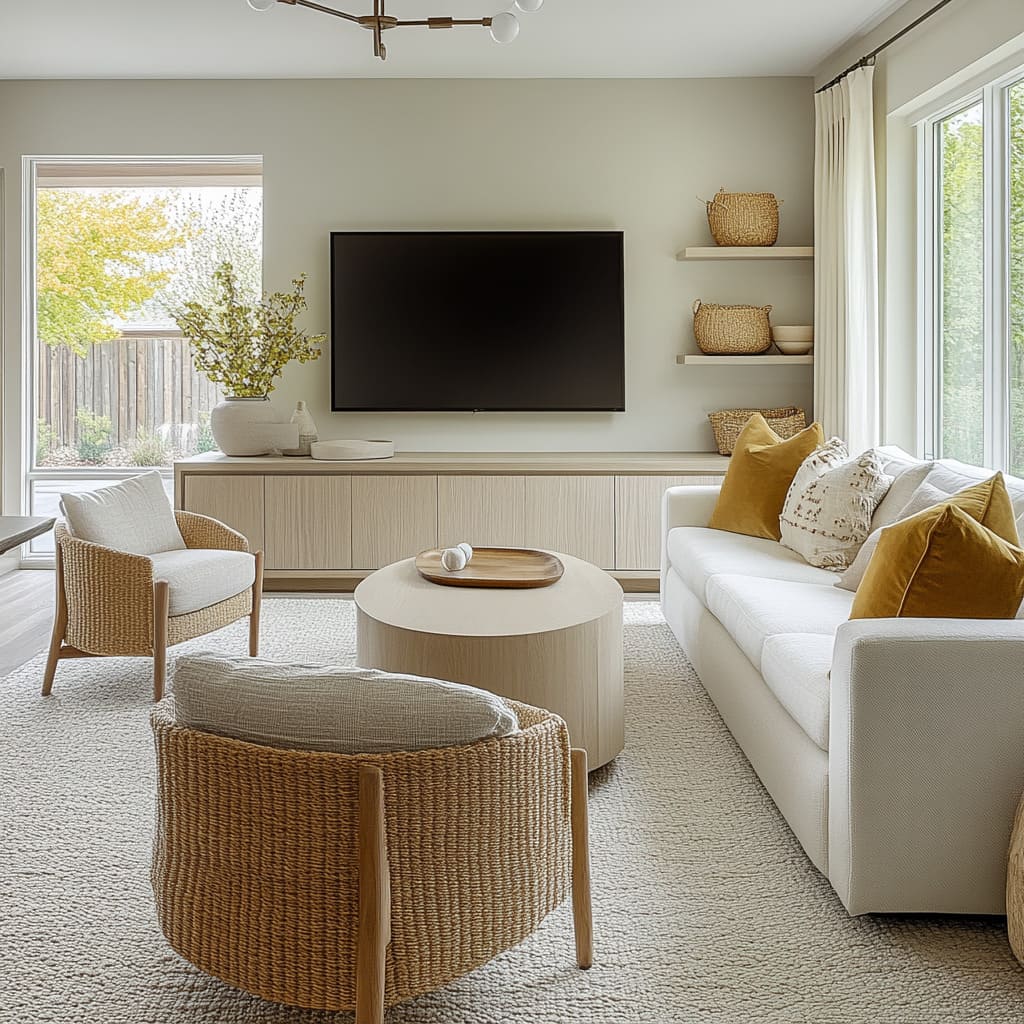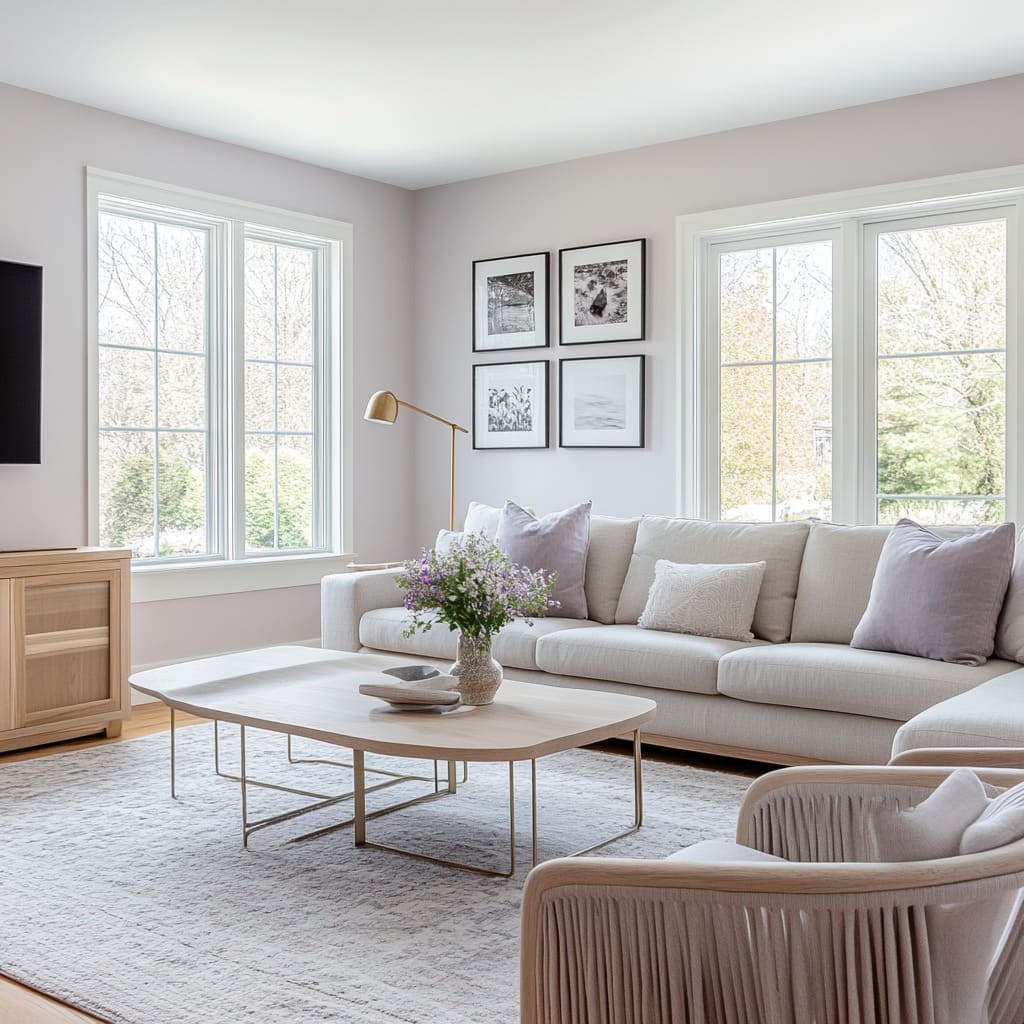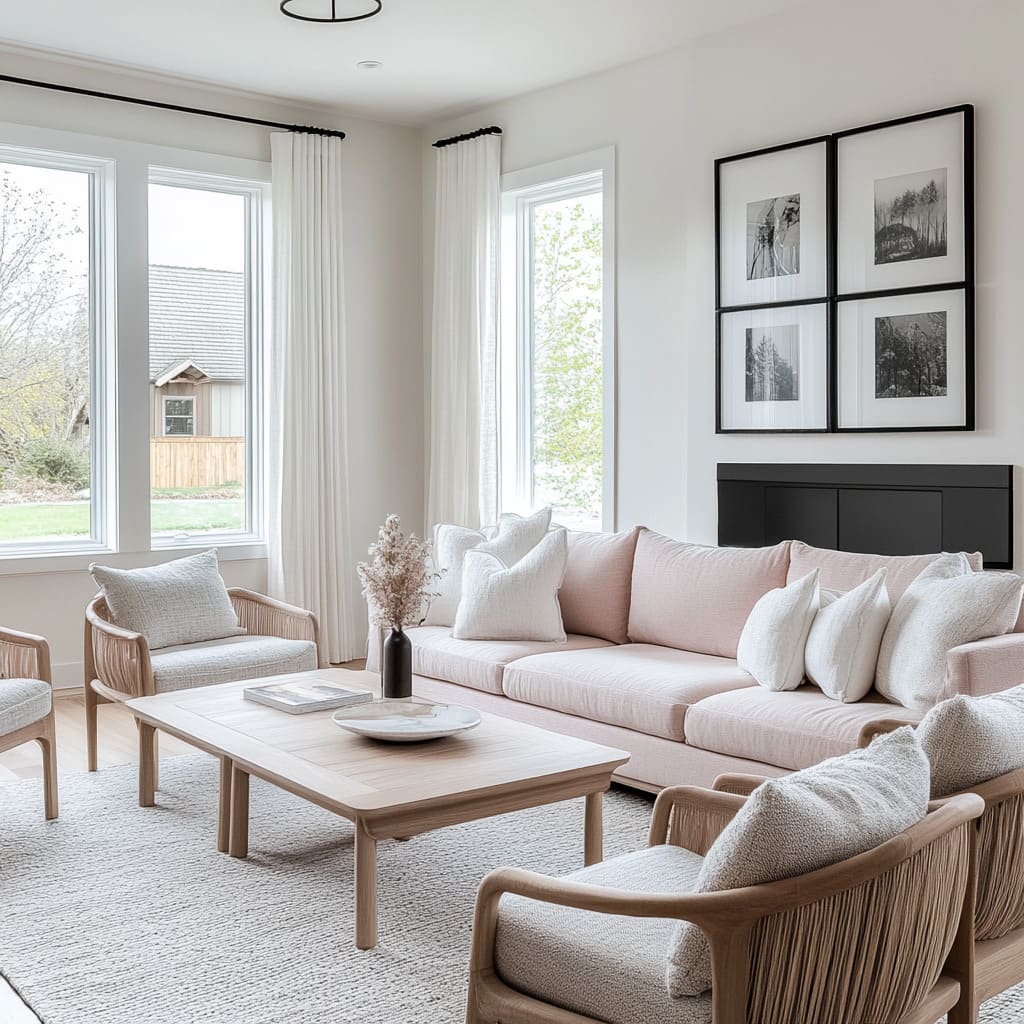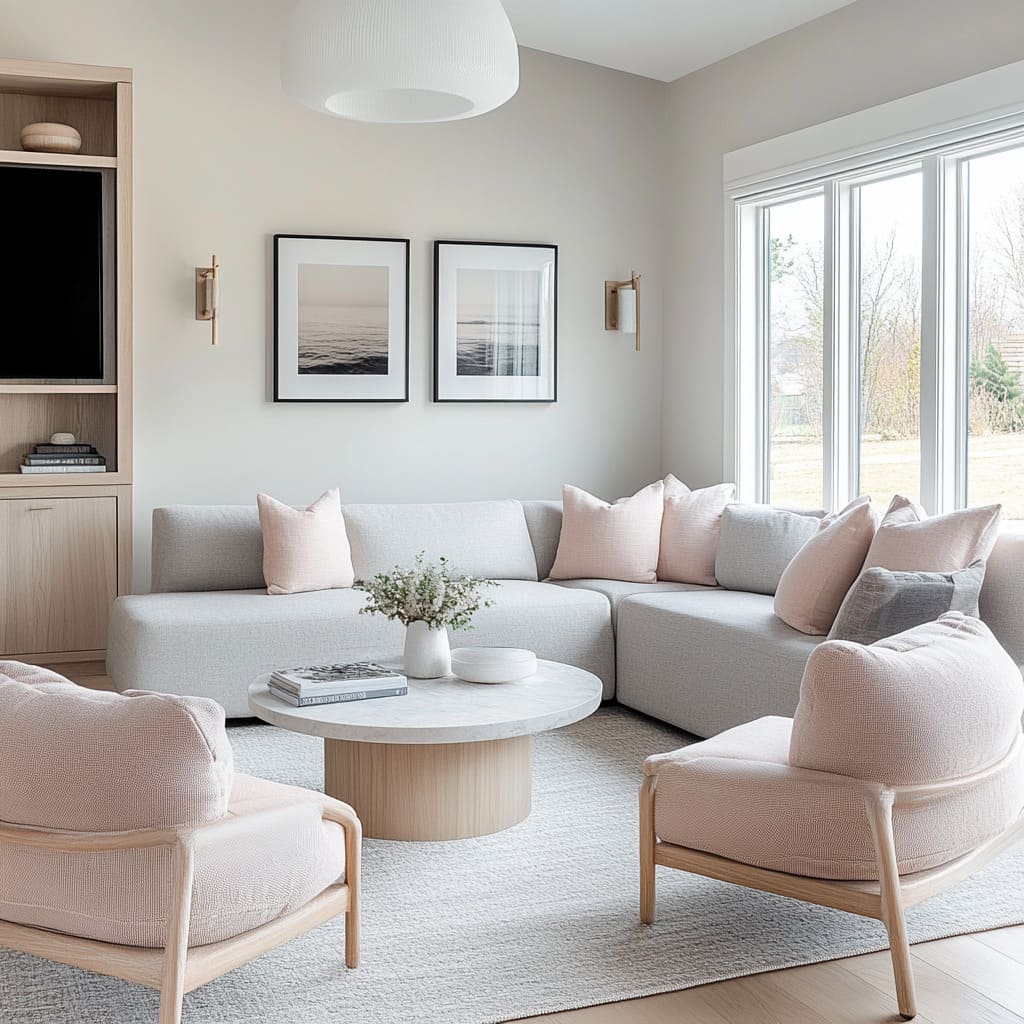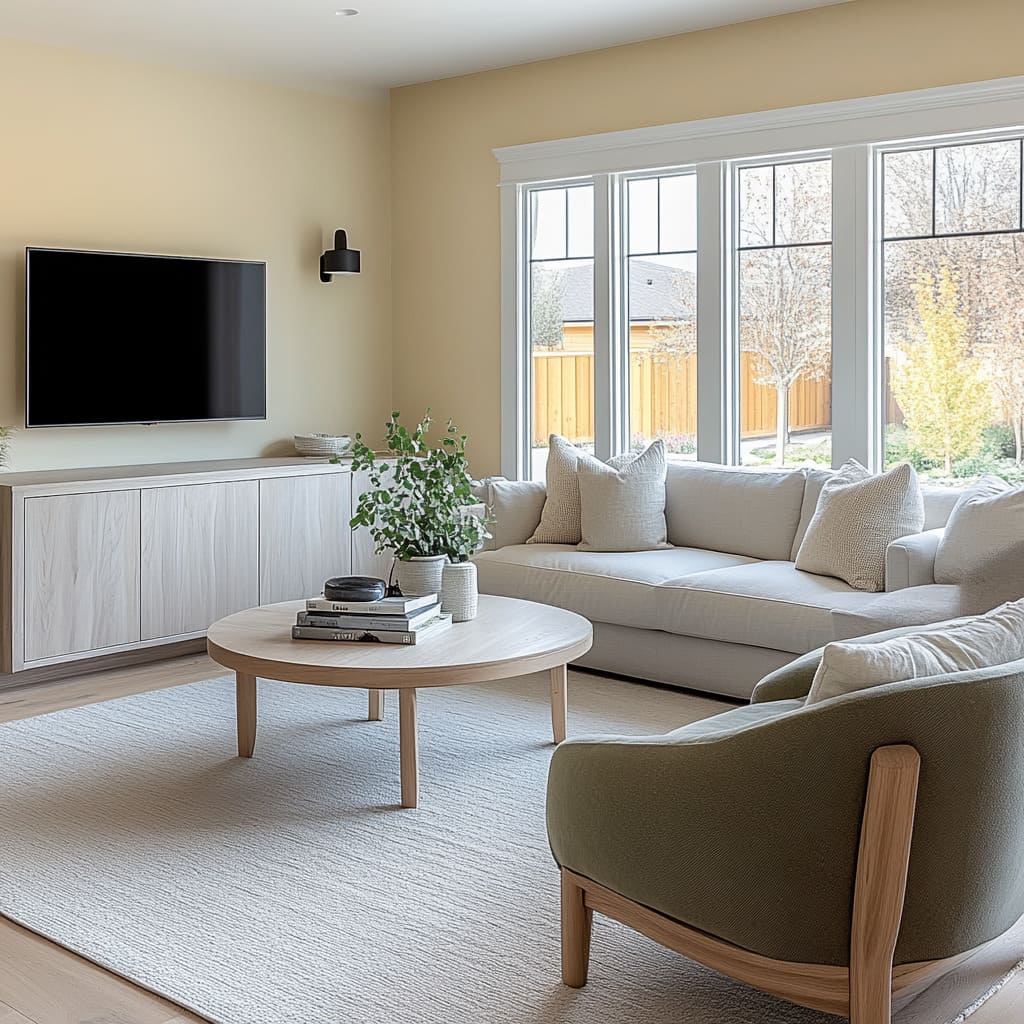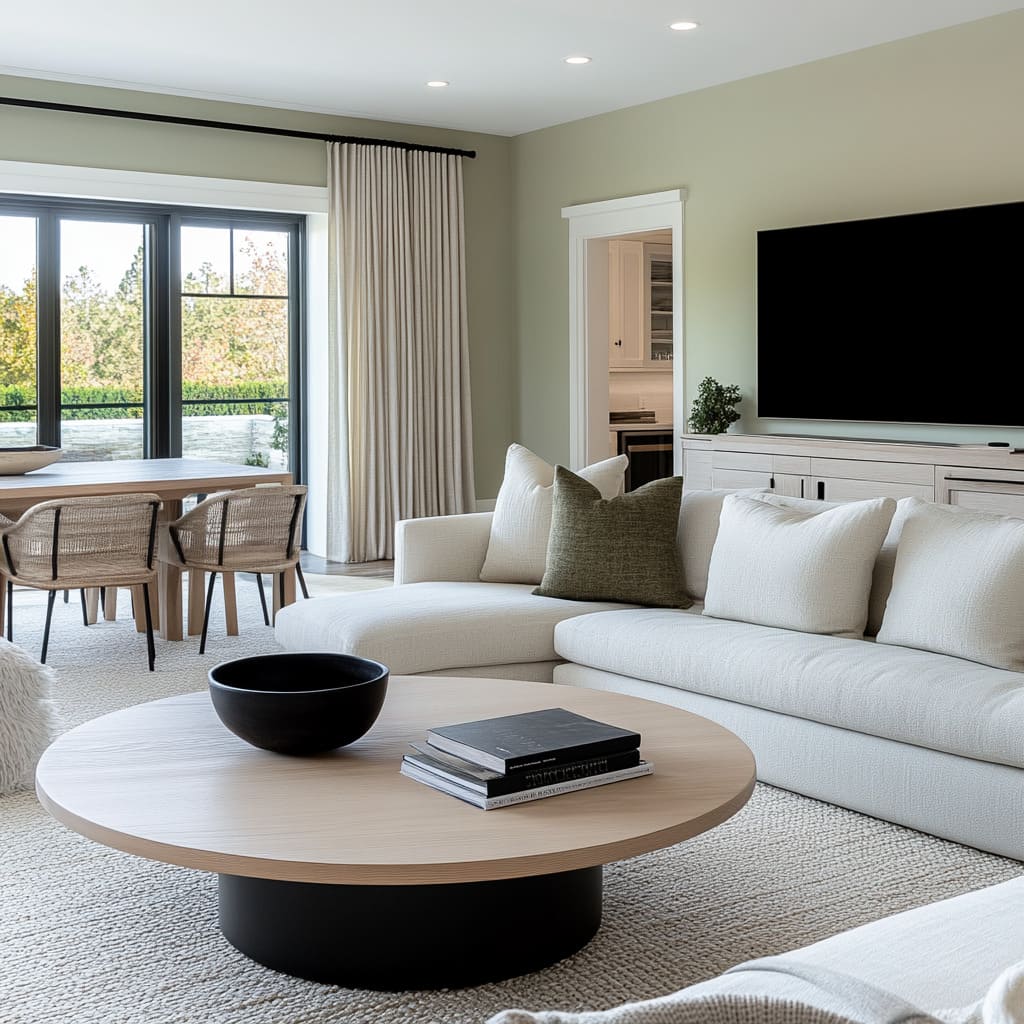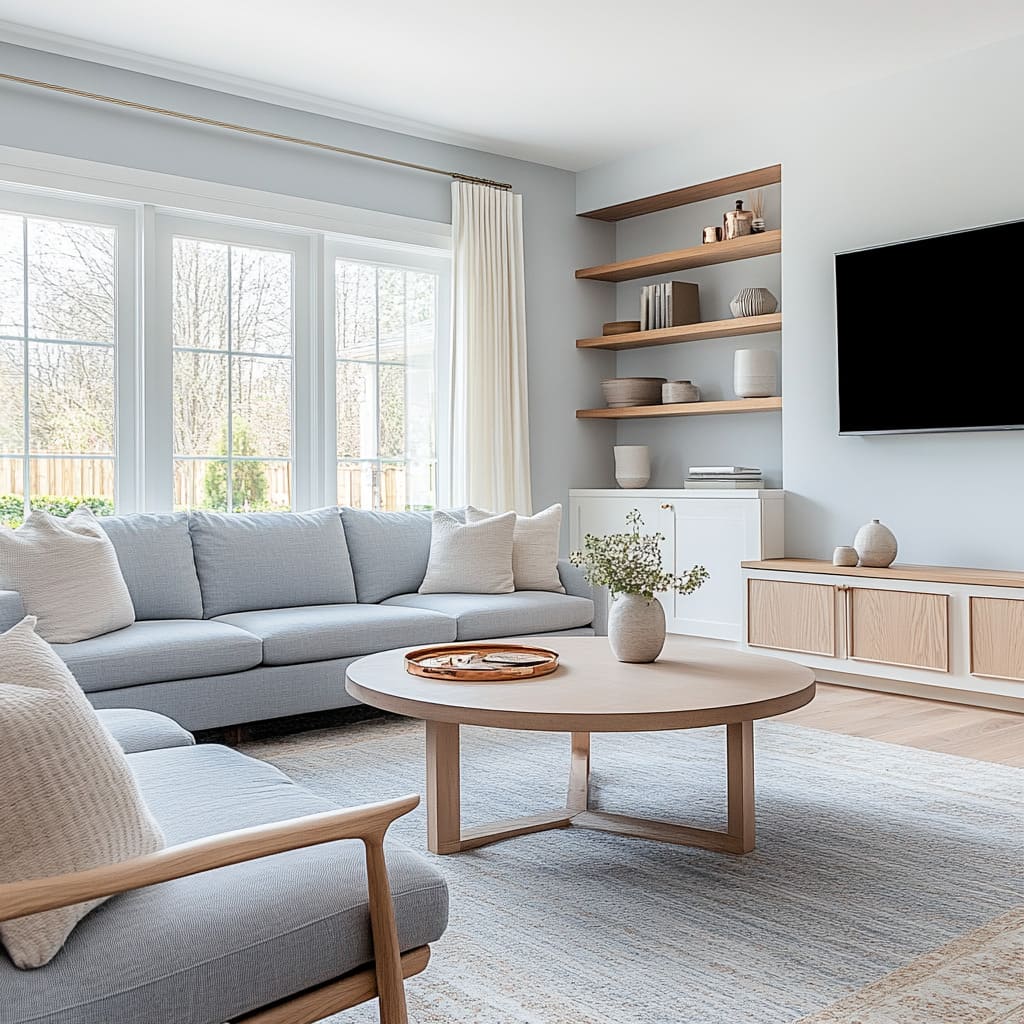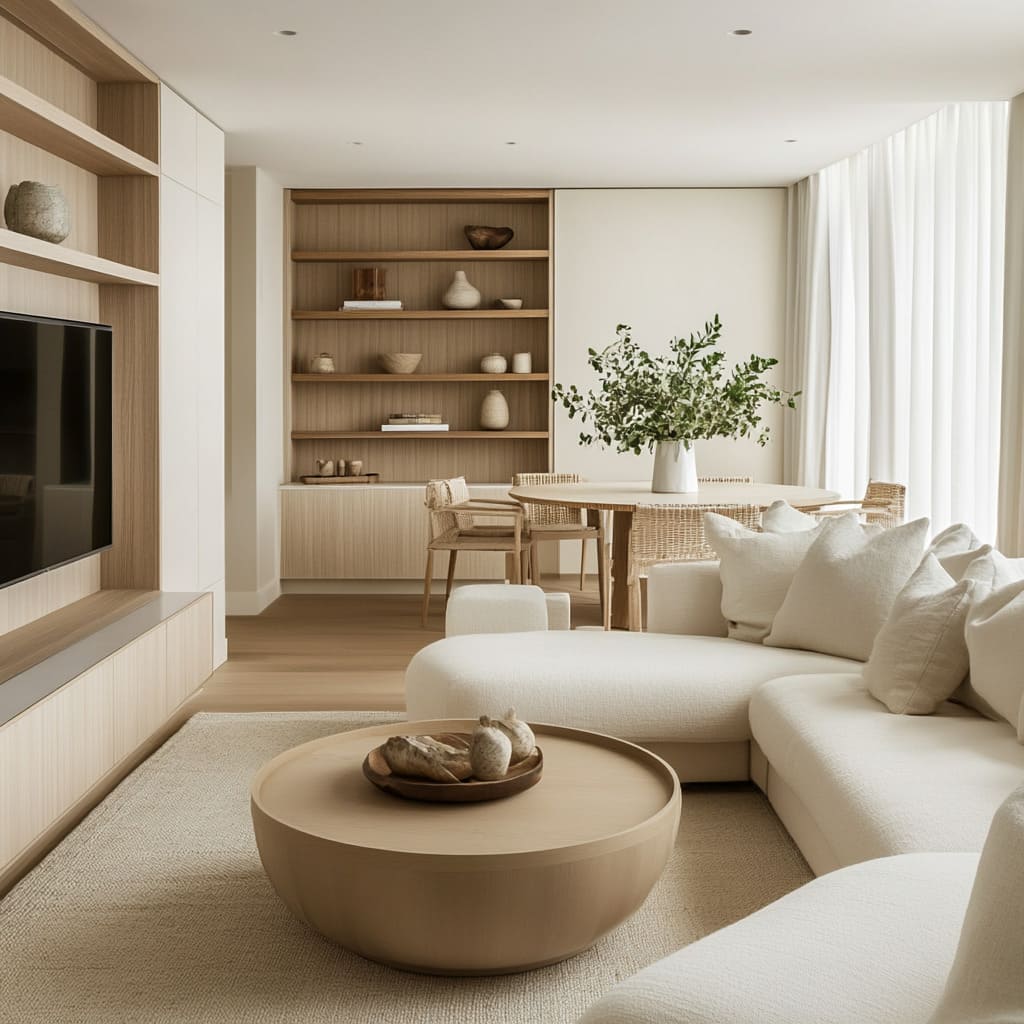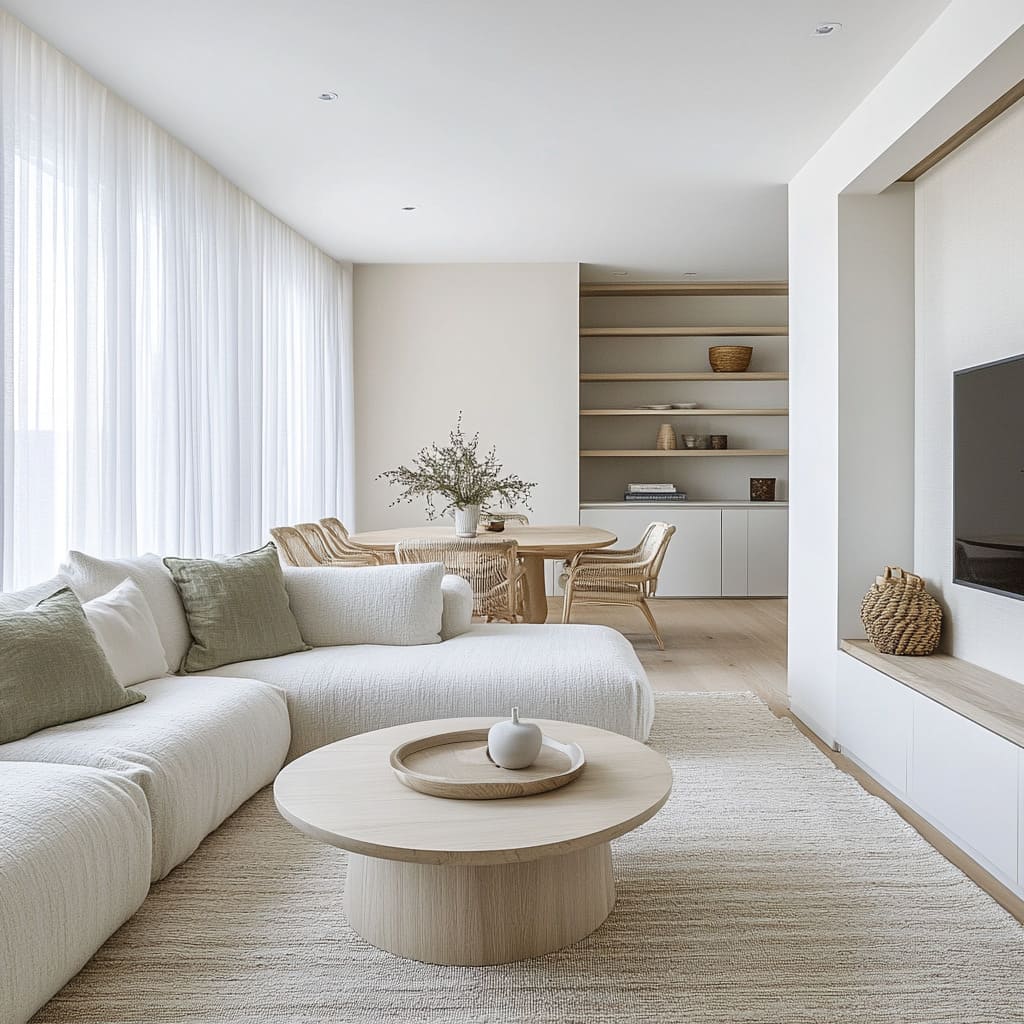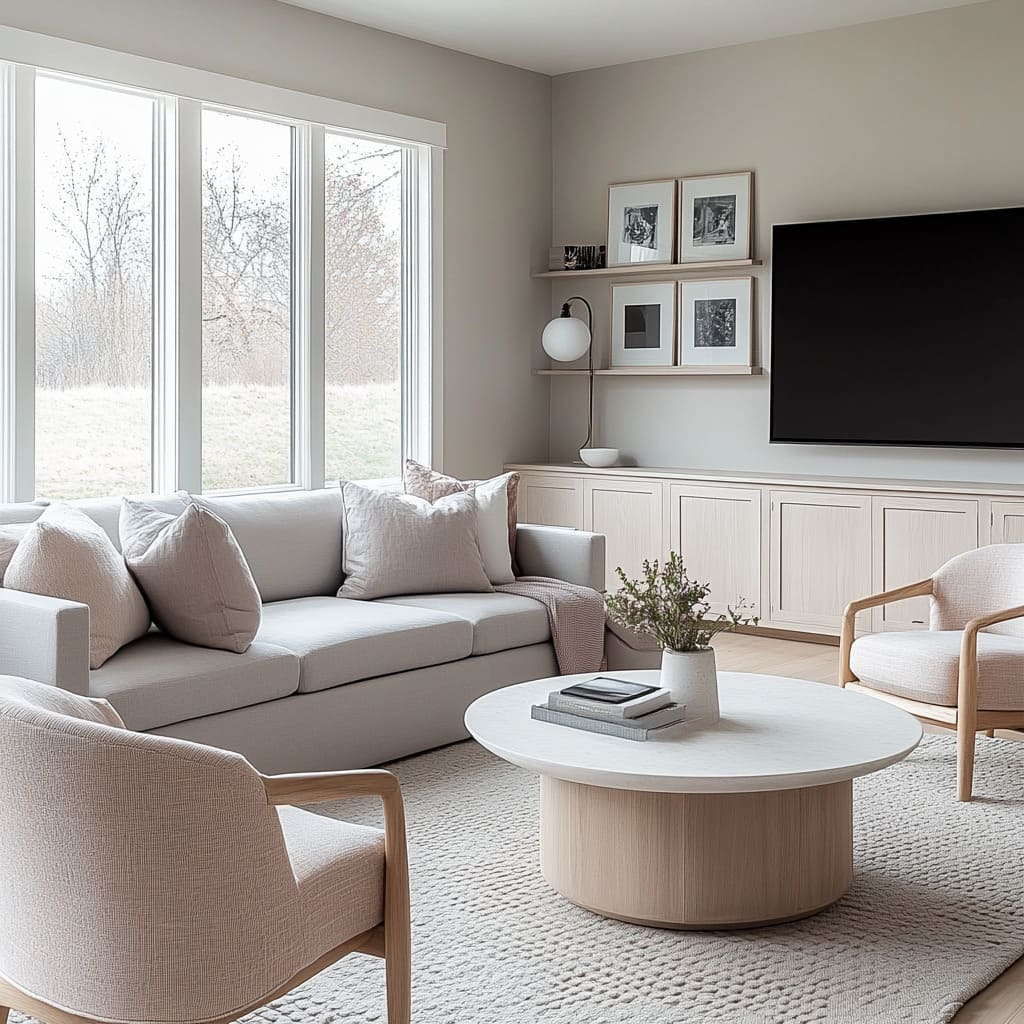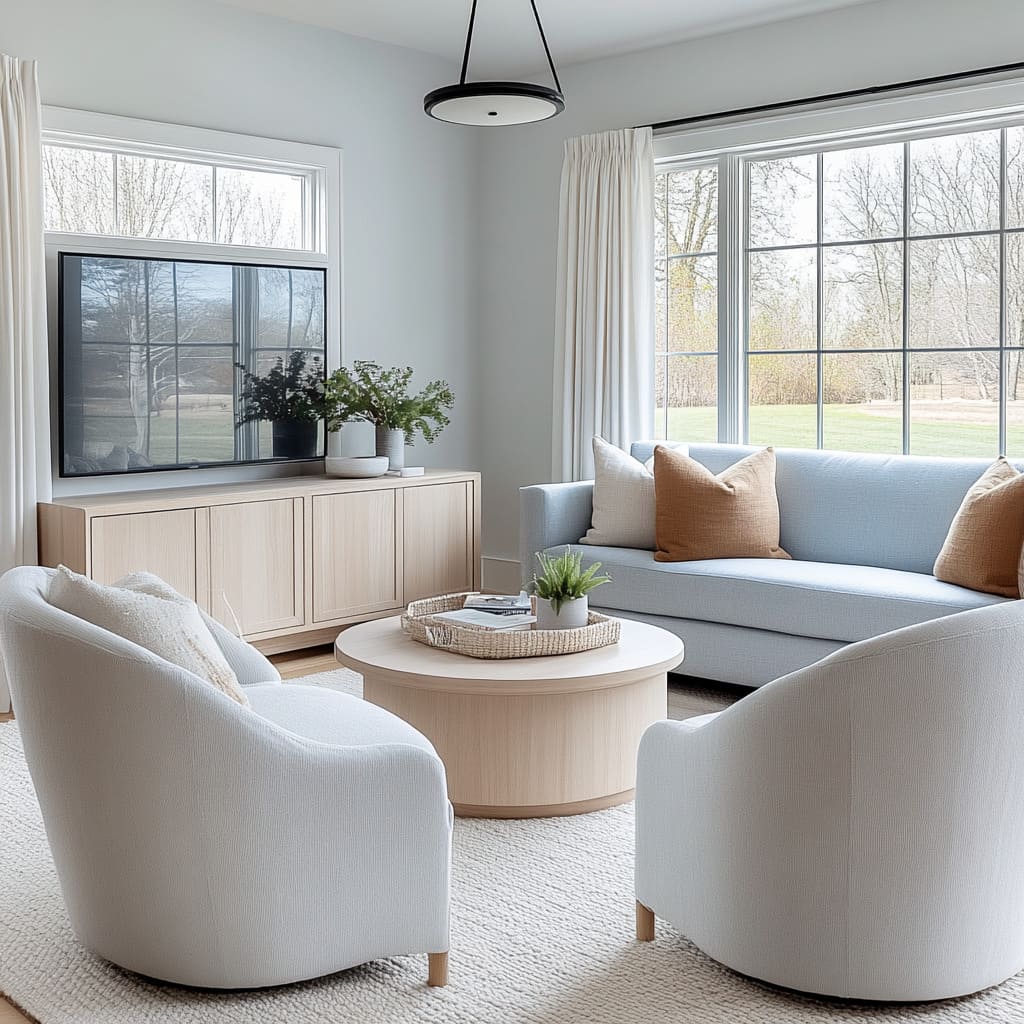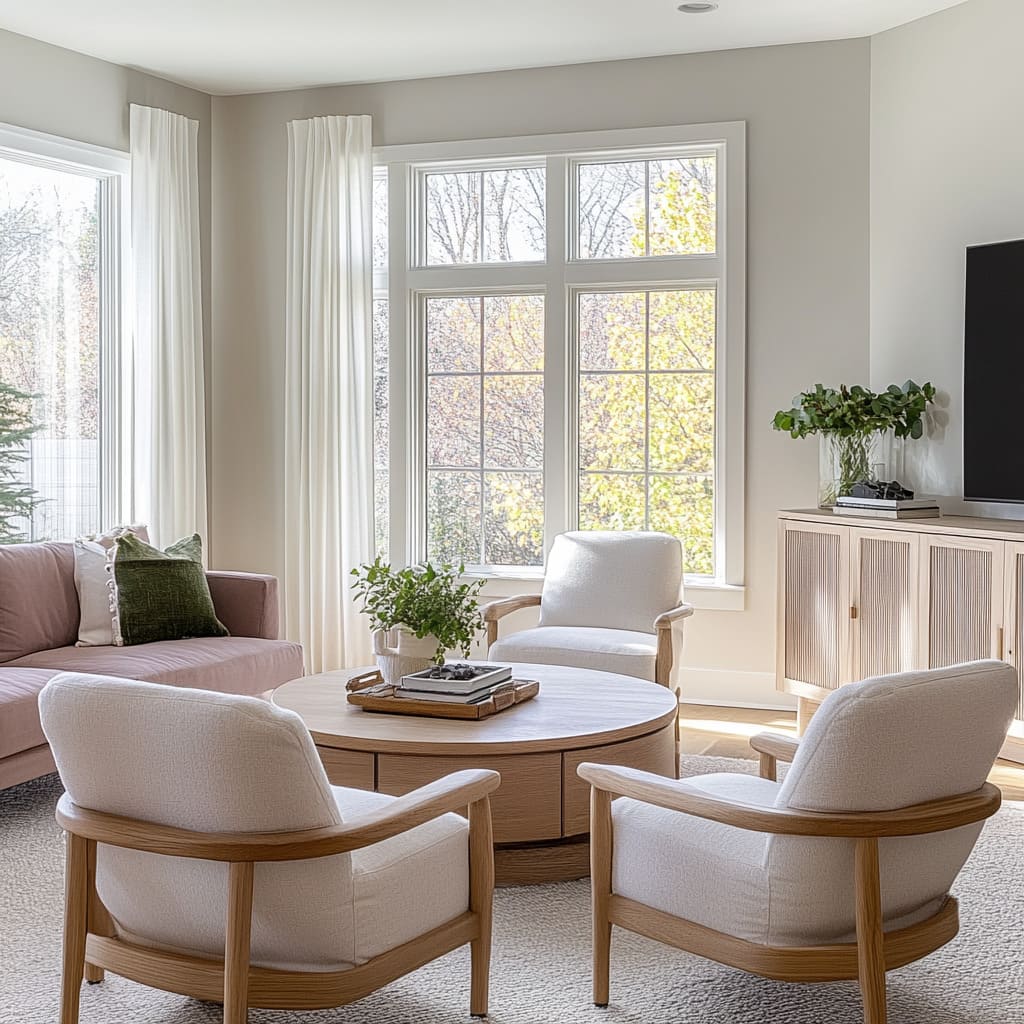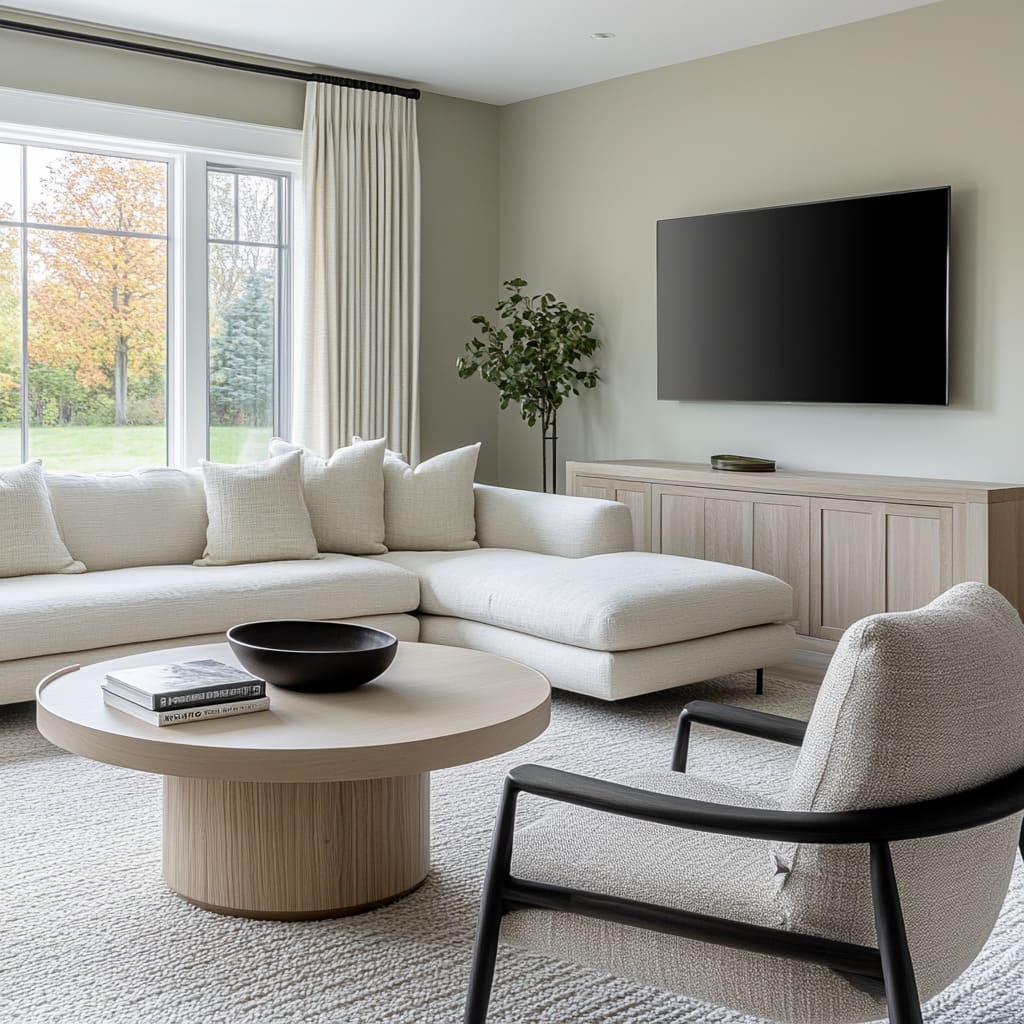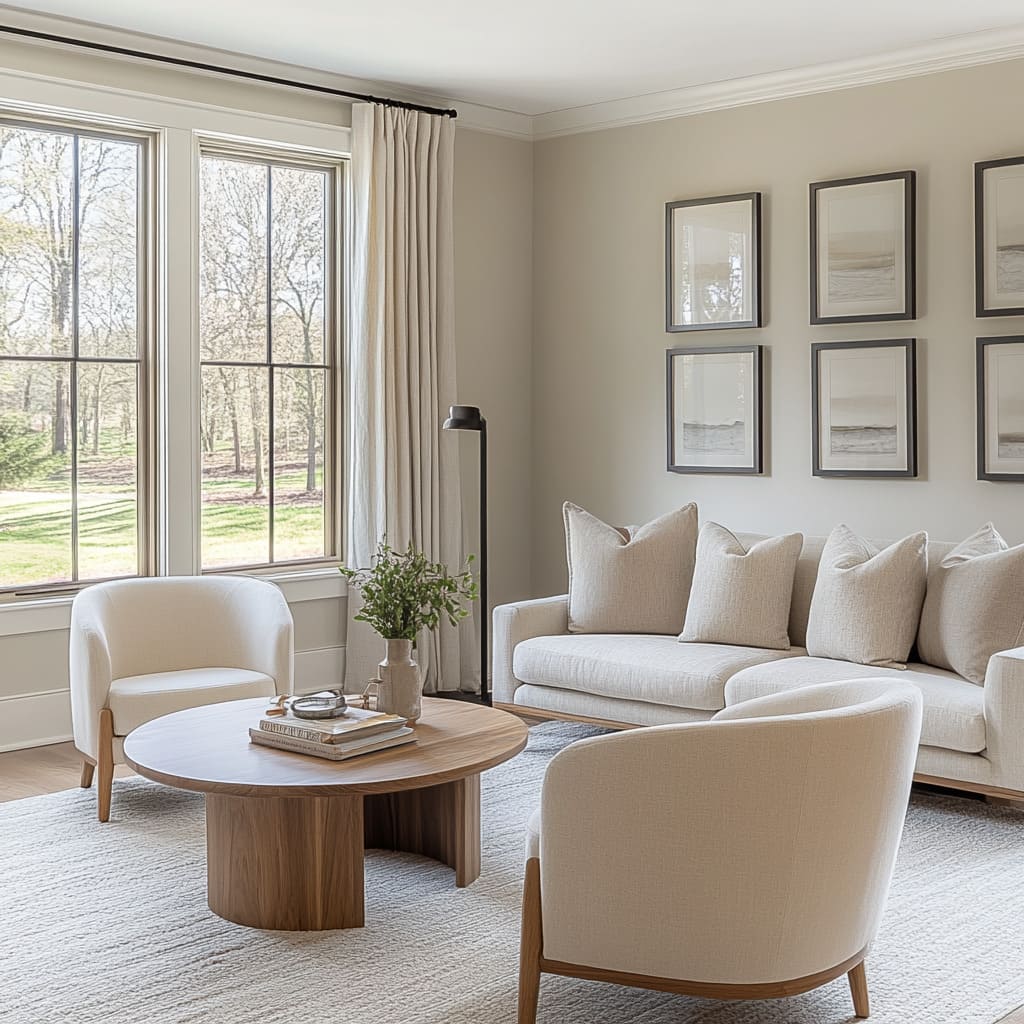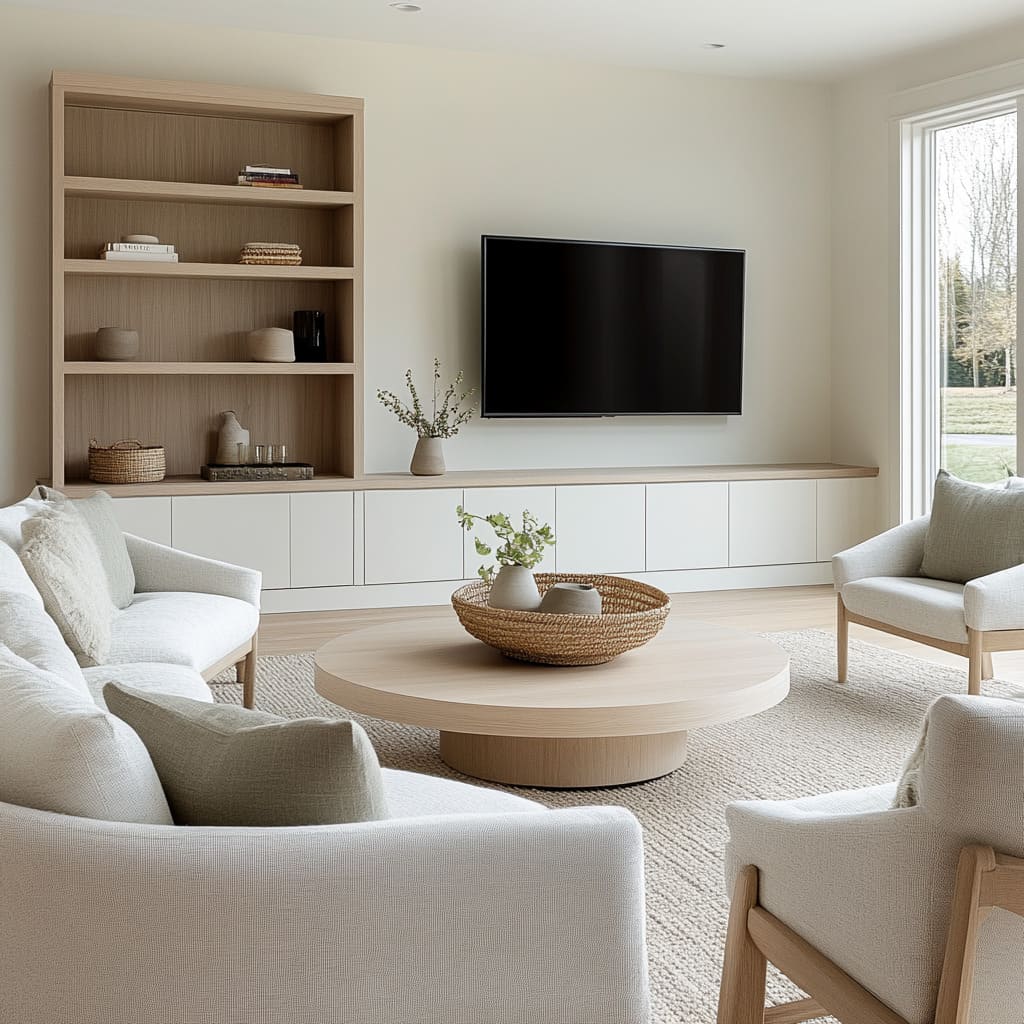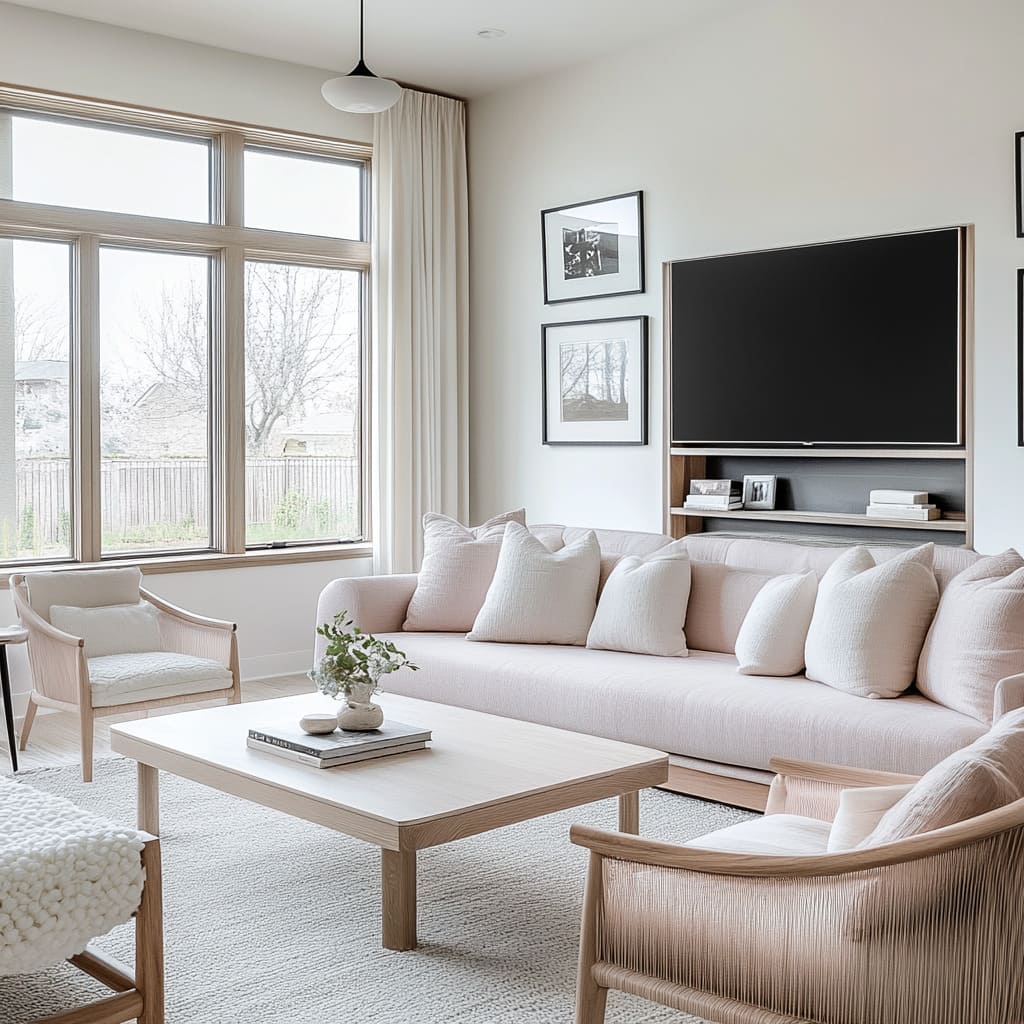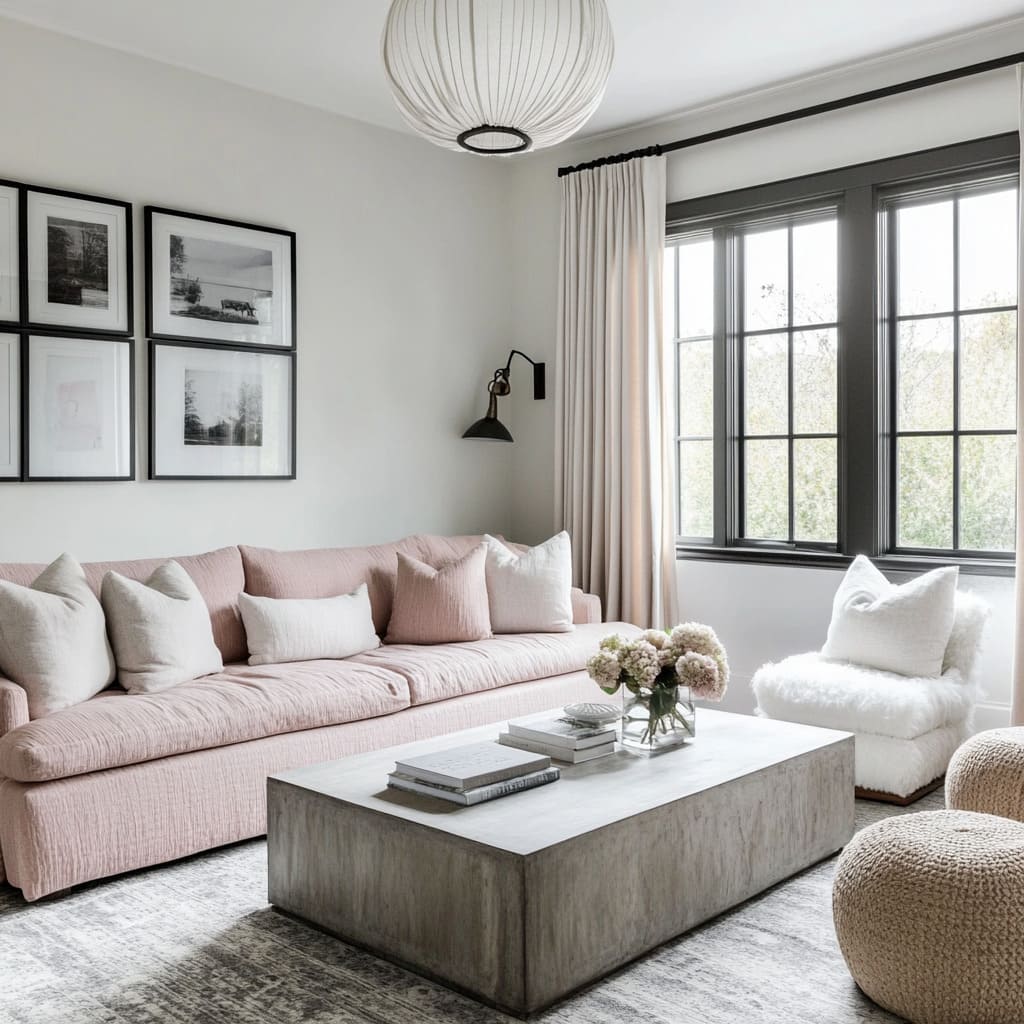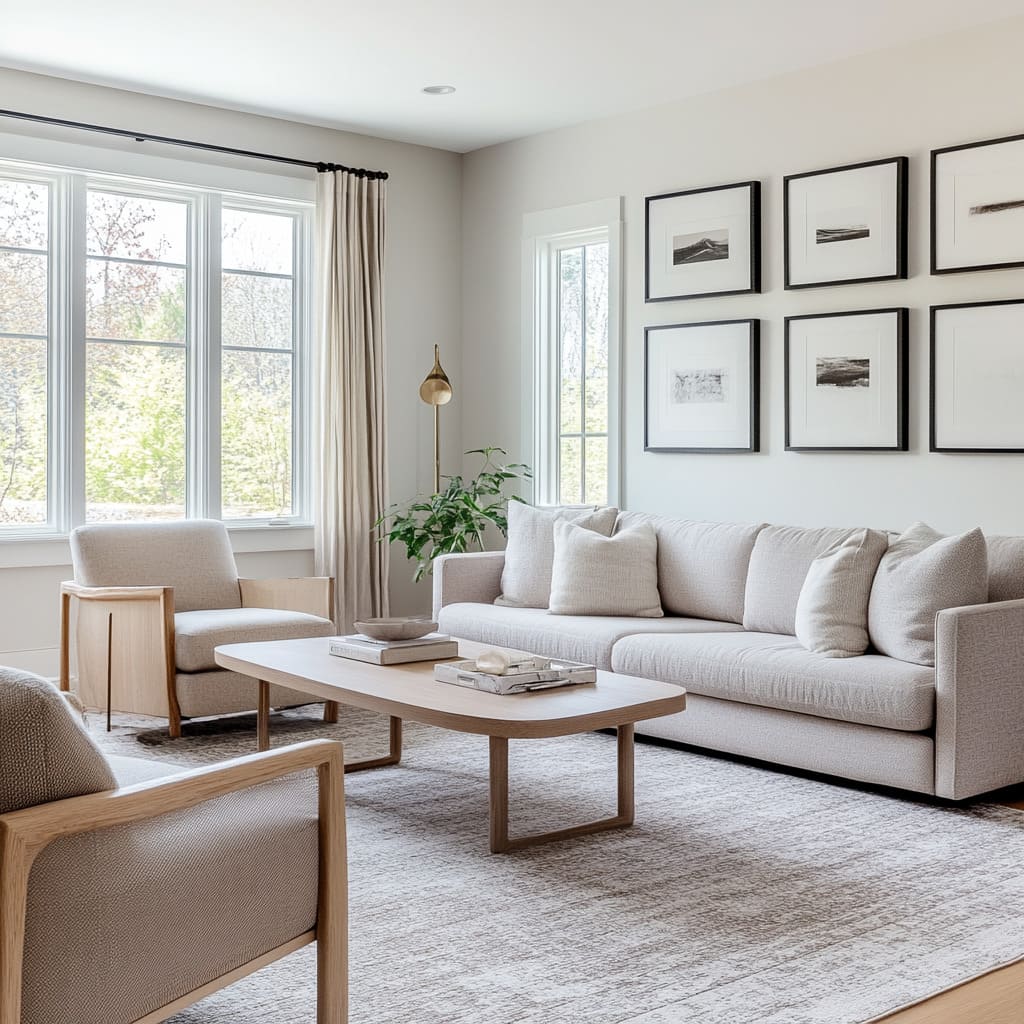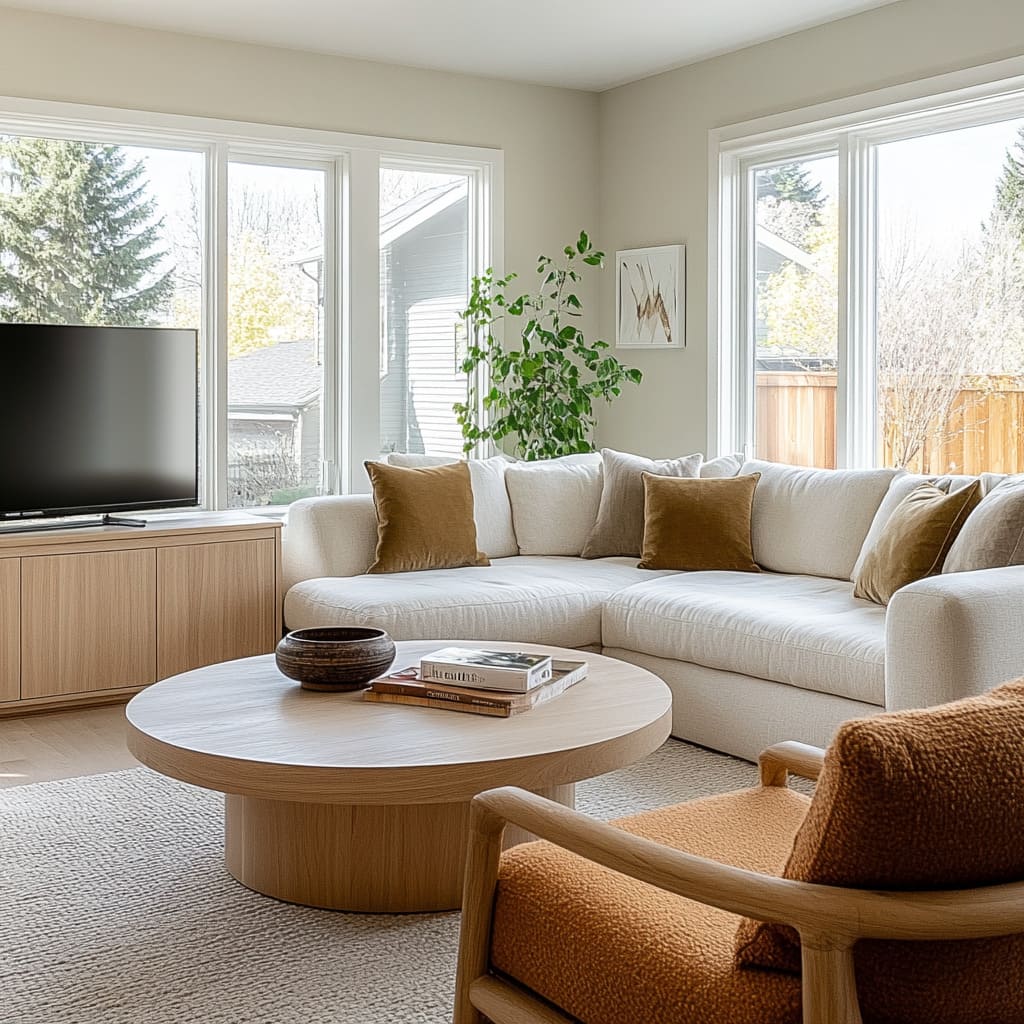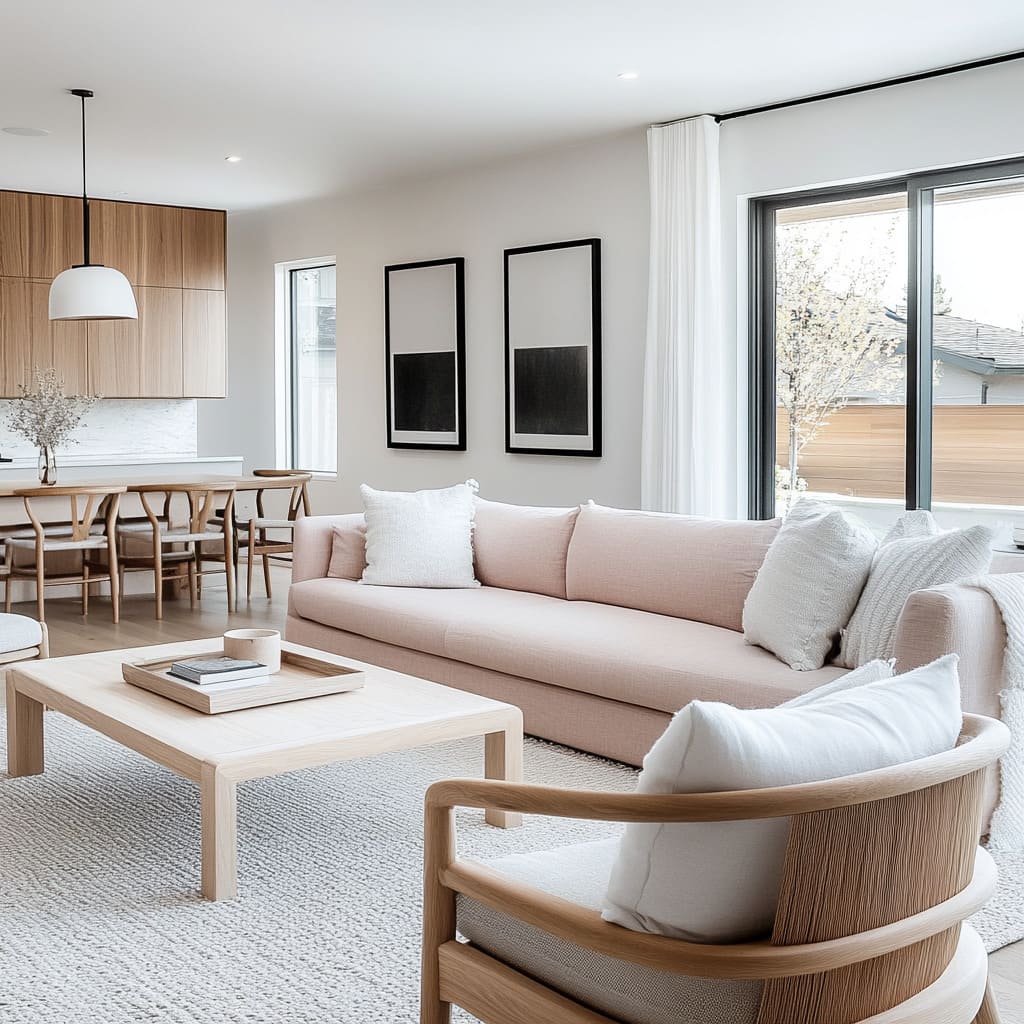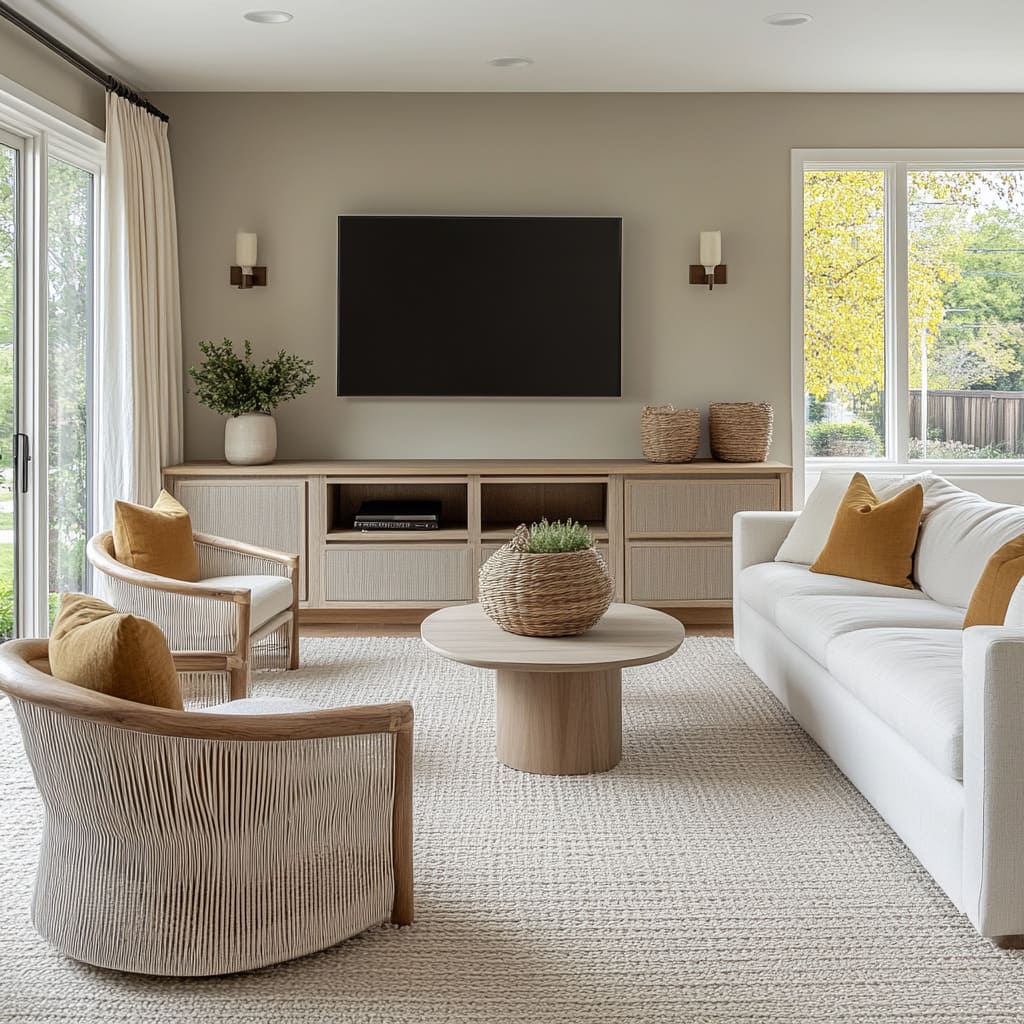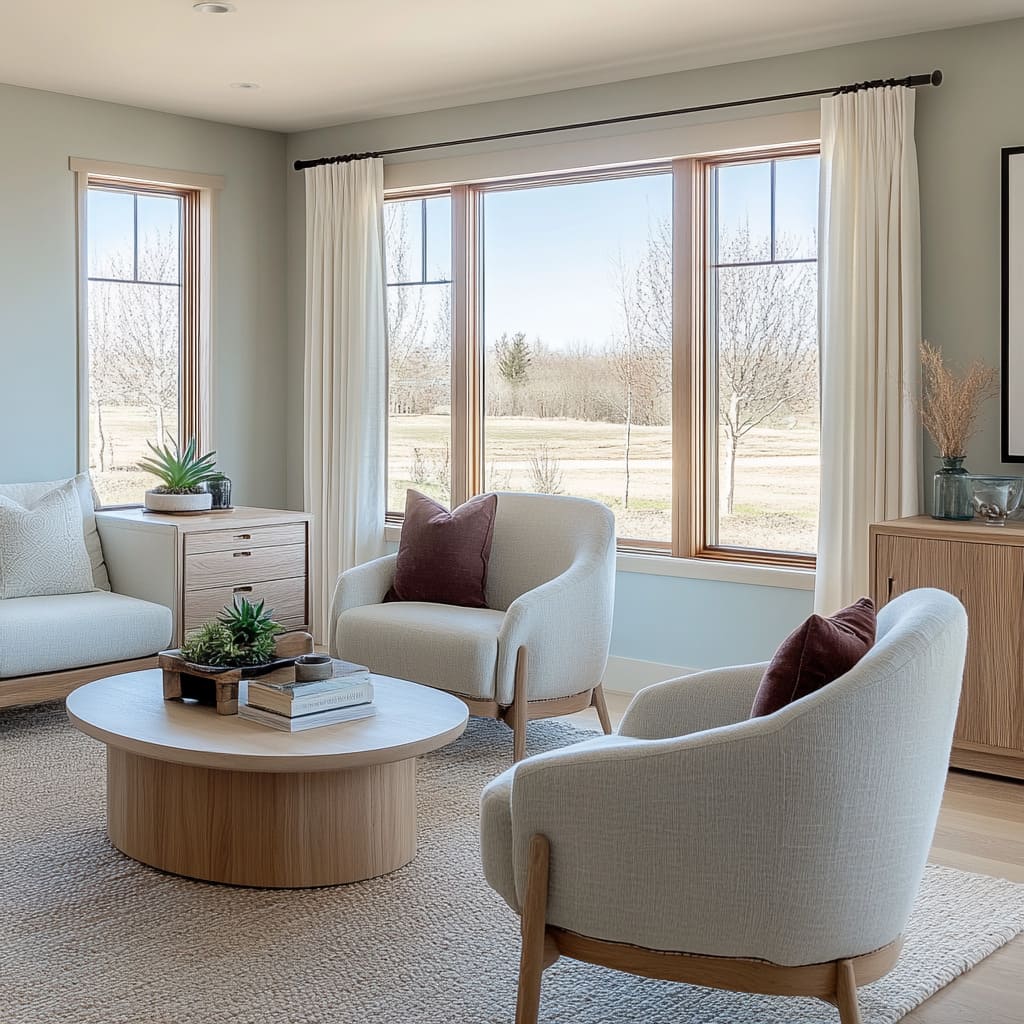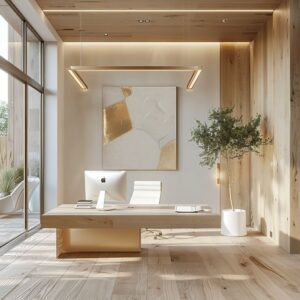Scandinavian design has captured the hearts of homeowners and interior designers worldwide for its blend of simplicity, practicality, and timeless appeal. This design style is celebrated for its clean lines, minimalistic approach, and ability to create a warm and inviting atmosphere without excess.
Its enduring popularity lies in its ability to transform any living space into a calm and comfortable haven, where every element serves both a functional and aesthetic purpose. With a focus on natural materials, soft textures, and a neutral color palette, Scandinavian design effortlessly combines form and function, making it a favorite choice for those seeking a balanced and harmonious living environment.
In this article, we will provide a comprehensive guide on how to bring the essence of Scandinavian design into your living room. We will explore key aspects such as the most suitable wall colors and the best furniture choices to help you create a Scandinavian-inspired space that feels both cozy and stylish.
Whether you are starting from scratch or looking to refresh an existing room, we will provide practical tips and Scandinavian living room ideas to help you achieve a look that is both modern and timeless
By following the principles of Scandinavian design, you will learn how to incorporate the right color palettes, furniture styles, natural lighting, and decor elements that define a Scandinavian-style living room. From understanding the importance of a neutral base and the impact of accent colors to selecting the right furniture that embodies both simplicity and functionality, this guide will cover everything you need to know to create a warm Scandinavian living room
Understanding Scandinavian Design Principles
Key Characteristics of Scandinavian Design
To achieve the Scandinavian look, it’s essential first to understand the core principles that define this style. At its heart, Scandinavian design is about creating a space that feels light, open, and uncluttered.
This is achieved through a focus on minimalism and simplicity, where every piece of furniture and decor has a purpose and contributes to the overall aesthetic
Minimalism and Simplicity:
One of the hallmarks of Scandinavian design is its minimalist approach. This means clean lines, clutter-free spaces, and a focus on the essentials.
In a Scandinavian living room, less is more. The emphasis is on creating a space that feels open and airy, with plenty of room to move around.
Furniture pieces are carefully chosen for their simplicity and elegance, often featuring sleek silhouettes and understated details. The goal is to create a space that is both functional and aesthetically pleasing without unnecessary embellishments or ornate details.
Functionality:
Functionality is another cornerstone of Scandinavian design. Every piece of furniture is chosen not only for its aesthetic appeal but also for its practicality.
This is where the concept of multifunctional furniture comes into play. In a Scandinavian minimalist living room, you might find coffee tables that double as storage units, or sofas with built-in shelves.
The idea is to maximize the use of space while maintaining a clean and uncluttered look. This focus on functionality ensures that every element in the room serves a purpose, contributing to a cohesive and well-thought-out design
Natural Elements:
Scandinavian design is also deeply rooted in nature. This is reflected in the use of natural materials such as wood, wool, cotton, and linen.
Light wood finishes, such as oak or pine, are particularly popular in Scandinavian interiors, adding warmth and texture to the space. These materials help to create a warm and inviting atmosphere that feels connected to the natural world.
In addition to wood, you might also find natural fibers in textiles, such as wool throws or cotton cushions, which add softness and comfort to the room.
Connection to Nature:
Another important aspect of Scandinavian design is its emphasis on connecting the indoors with the outdoors.
This is often achieved through the inclusion of large windows that allow plenty of natural light to flood the space. The idea is to bring the outside in, creating a seamless transition between the interior and the natural environment.
This connection to nature can also be enhanced through the use of indoor plants, which add a touch of greenery and life to the space. By incorporating natural elements and maximizing natural light, Scandinavian design creates a space that feels open, airy, and harmonious
The Color Palette of Scandinavian Living Rooms
The color palette is a fundamental element of Scandinavian design, playing a crucial role in creating the desired atmosphere. Scandinavian interiors are known for their use of soft, neutral colors that help to create a calm and inviting space.
Neutral Base Colors:
A neutral base is essential for achieving a Scandinavian look. Colors such as white, beige, soft grays, and light pastels are often used as the foundation for the design.
These colors help to create a bright and airy feel, making the space appear larger and more open. White and off-white are particularly popular for walls, as they reflect light and enhance the room’s natural brightness.
Soft grays and light pastels, such as blush pink or pale blue, can also be used to add a touch of warmth and sophistication without overpowering the space.
Accent Colors:
While the base of a Scandinavian living room is typically neutral, accent colors can be used to add depth and interest to the design. Muted greens, blush pinks, and earthy tones are commonly used as accent colors in Scandinavian interiors.
These colors are subtle and understated, adding warmth and personality to the space without detracting from the overall simplicity of the design. For example, a few carefully chosen throw pillows in muted greens or a soft, blush pink rug can add a pop of color that enhances the room’s aesthetic while maintaining its minimalist feel
Choosing the Right Wall Colors for a Scandinavian Living Room
The Best Neutral Colors for Walls
Choosing the right wall colors is essential for achieving a Scandinavian look in your living room. The goal is to create a backdrop that enhances the room’s natural light and complements the simplicity of the furniture and decor.
White and Off-White:
White and off-white are the go-to colors for walls in a Scandinavian living room. These colors create a bright and airy feel, making the space appear larger and more open.
White walls reflect light, enhancing the room’s natural brightness and creating a clean, fresh look. Off-white tones, such as cream or ivory, can also be used to add a touch of warmth while maintaining the room’s light and open feel.
Soft Grays:
Soft grays are another popular choice for walls in a Scandinavian living room. These colors add a modern touch while maintaining neutrality.
Soft grays can create a sophisticated backdrop that complements the room’s furniture and decor, adding depth and interest without overpowering the space. Light gray walls can also help to create a calm and soothing environment, perfect for a Scandinavian sitting room.
Warm Beige and Light Taupe:
Warmer neutrals, such as beige and light taupe, are also commonly used in Scandinavian interiors. These colors add a comforting effect, creating a warm Scandinavian living room that feels both cozy and inviting.
Beige and taupe tones can provide a subtle contrast to the room’s lighter elements, adding depth and dimension to the design while maintaining a cohesive and harmonious look
Adding Depth with Accent Walls
While a neutral base is essential for a Scandinavian look, accent walls can be used to add depth and contrast to the space. The key is to choose colors that complement the room’s overall palette while introducing a touch of interest.
Muted Green and Mint:
Soft shades of green, such as muted green or mint, can be used to create a calming, nature-inspired feel. These colors add a subtle touch of color that enhances the room’s connection to nature, creating a peaceful and harmonious environment.
A mint green accent wall, for example, can provide a fresh and uplifting backdrop for a Scandinavian lounge, adding a touch of color that complements the room’s neutral base.
Charcoal Gray and Other Deep Shades:
Darker hues, such as charcoal gray or deep blue, can also be used on accent walls to add contrast and depth to a Scandinavian living room.
These colors create a striking focal point without overpowering the space, adding a modern and sophisticated touch to the design. A charcoal gray accent wall, for example, can provide a bold contrast to the room’s lighter elements, creating a dynamic and visually interesting space.
By carefully selecting the right wall colors and furniture pieces, you can create a Scandinavian living room that feels both cozy and stylish, combining the best of modern design with timeless elegance
Selecting Scandinavian-Inspired Furniture
Creating a Scandinavian-style living room involves more than just choosing the right colors; it also requires thoughtful selection of furniture that complements the simplicity and functionality characteristic of this design. The furniture in a Scandinavian living room is chosen for its clean lines, practicality, and the way it contributes to a light, airy atmosphere.
This section will explore the essential furniture pieces that define the Scandinavian style and the material choices that bring the aesthetic to life
Essential Furniture Pieces
Sofas and Sectionals:
In Scandinavian living rooms, sofas and sectionals serve as the centerpiece of comfort and style. These seating pieces are characterized by their clean lines, minimalistic design, and light upholstery.
Typically, Scandinavian-style sofas feature simple, low-profile shapes that prioritize comfort without unnecessary bulk. Upholstery choices often lean toward neutral shades like white, beige, or light gray, enhancing the room’s bright and airy feel.
Some sofas may also incorporate soft pastel tones to add a subtle touch of color without detracting from the minimalist aesthetic. The structure of these sofas is often straightforward, with a focus on durability and comfort, making them an ideal choice for both large family rooms and more intimate settings, such as a Scandinavian small living room
Accent Chairs:
Accent chairs in a Scandinavian-inspired living room are more than just additional seating—they are an opportunity to introduce texture and warmth into the space. Popular styles include chairs with light wood frames, such as ash or birch, paired with simple, upholstered cushions in neutral fabrics.
These chairs often feature sleek, curved lines that add a touch of softness to the room’s overall design. The use of natural materials like wood and linen in these chairs contributes to the inviting, cozy atmosphere typical of Scandinavian interiors.
These pieces not only provide functional seating but also serve as focal points that enhance the room’s aesthetic. For those exploring Scandinavian living room ideas, incorporating a few well-placed accent chairs can significantly elevate the room’s look and feel.
Coffee Tables:
A key element in Scandinavian design is the coffee table, which often serves as the central hub of a living room. Scandinavian coffee tables are typically crafted from light wood, such as oak or pine, and feature simple, rounded shapes.
The choice of light wood adds a natural warmth to the room, creating a welcoming environment that is both functional and visually appealing. The rounded edges of these tables add softness to the space, complementing the clean lines of the sofas and chairs.
This combination of form and function makes them a perfect addition to any Scandinavian-style living room, particularly in spaces aiming for a blend of modern comfort and traditional charm, such as a Scandinavian farmhouse living room
Material Choices for Scandinavian Furniture
Light Wood Finishes:
One of the most defining features of Scandinavian furniture is the use of light wood finishes. Woods like ash, birch, and oak are commonly used to craft everything from sofas and chairs to coffee tables and shelving units.
These woods are chosen for their durability and their light, natural appearance, which helps to brighten the room and create a sense of space. Light wood finishes are particularly effective in reflecting natural light, contributing to the open, airy feel that is a hallmark of Scandinavian design.
For anyone considering Scandinavian living room ideas, incorporating light wood elements is essential to achieving the desired look.
Natural Textiles and Upholstery:
In Scandinavian design, the choice of textiles is just as important as the furniture itself.
Natural fabrics like cotton, linen, and wool are commonly used for upholstery, curtains, and soft furnishings. These materials not only add comfort but also enhance the natural, organic feel of the space.
Upholstery in neutral shades such as white, beige, and gray allows for versatility and complements the room’s color palette, while textured fabrics add depth and interest. Using natural textiles is a key strategy in creating a cozy and inviting atmosphere, making these materials ideal for both large and small Scandinavian living rooms.
Incorporating Rattan and Wicker:
Rattan and wicker are often incorporated into Scandinavian design to add texture and warmth. These materials are typically used in accent pieces like chairs, side tables, and storage baskets.
The woven nature of rattan and wicker introduces a natural, handcrafted element to the room, adding to the layered, textured look that is so effective in Scandinavian interiors. These materials are versatile and durable, making them suitable for both traditional and modern settings.
Whether in the form of a chic rattan chair or a simple wicker basket, these elements can provide a sense of warmth and coziness that enhances the overall design
Lighting and Accessories for a Scandinavian Living Room
Lighting and accessories play a crucial role in Scandinavian interior design. They not only provide functionality but also help to enhance the aesthetic and atmosphere of the living room.
This section will explore how to maximize natural light, choose the right artificial lighting, and incorporate accessories that complement the Scandinavian style
Maximizing Natural Light
Window Treatments:
In Scandinavian design, maximizing natural light is essential to creating a bright and inviting space. Window treatments should be kept simple and light to allow as much daylight as possible to filter through.
Sheer curtains in off-white or beige are a popular choice, as they provide privacy while still letting in plenty of light. These light curtains can be layered over blinds for added flexibility, allowing homeowners to control the amount of light entering the room.
The use of sheer, light curtains is especially effective in creating a bright and airy atmosphere, which is a key element in Scandinavian living rooms
Placement of Windows and Light Sources:
The placement of windows and light sources is another important consideration in Scandinavian design. Large windows are a hallmark of this style, allowing for ample daylight and a strong connection to the outdoors.
In addition to natural light, it’s important to consider the placement of artificial light sources. Floor and table lamps should be strategically placed to complement the natural light and provide illumination in the evenings.
This combination of natural and artificial lighting helps to create a balanced and inviting environment that is both functional and aesthetically pleasing
Artificial Lighting Choices
Floor and Table Lamps: Artificial lighting is an essential component of Scandinavian design, particularly in regions where natural light may be limited during certain times of the year. Floor and table lamps with sleek, minimalist designs are ideal for Scandinavian interiors.
These lamps often feature neutral or metallic finishes, which complement the room’s color palette and add a touch of modern elegance. Choosing lamps with simple, clean lines helps to maintain the room’s uncluttered look while providing ample illumination for reading, relaxing, or entertaining
Ceiling Lights and Chandeliers:
Ceiling lights and chandeliers are also important elements in a Scandinavian living room. Modern yet subtle ceiling lights can help to enhance the room’s simplicity and clean lines.
Pendant lights with understated designs or chandeliers with a minimalist aesthetic are excellent choices for adding ambient light without overwhelming the space. The key is to choose fixtures that are both functional and aesthetically pleasing, complementing the room’s overall design
Decorative Elements and Textures
Wall Art:
When it comes to decorating a Scandinavian living room, wall art plays a significant role in adding personality and character. Monochromatic or minimalist art pieces in black frames are a popular choice, as they provide a striking contrast against light-colored walls.
These art pieces often feature simple designs or nature-inspired themes that complement the overall aesthetic. By incorporating black-framed art, you can add a bold yet subtle element to the room that enhances its visual appeal.
Textiles and Soft Furnishings:
Textiles and soft furnishings are key to creating a cozy and inviting atmosphere in a Scandinavian living room. Soft throws, cushions in muted colors, and textured fabrics are ideal for adding warmth and comfort to the space.
Layering different textures and fabrics can create a rich, tactile experience that enhances the room’s overall coziness. For those looking for Scandinavian small living room ideas, incorporating soft furnishings is a simple yet effective way to make the space feel more welcoming.
Nature indoors:
Bringing nature indoors is a fundamental aspect of Scandinavian design. Incorporating plants and greenery into the living room is a great way to add a touch of nature and life to the space.
Potted plants, hanging planters, or even a small indoor tree can provide a fresh, organic element that complements the room’s natural color palette. In addition to plants, natural elements like wooden bowls, ceramic vases, or woven baskets can add texture and warmth to the room, making it feel more connected to the natural world.
By carefully selecting furniture, lighting, and accessories that align with Scandinavian design principles, you can create a living room that is both stylish and functional, whether you are aiming for a traditional Scandinavian farmhouse living room or a more modern, minimalist interpretation
Flooring and Rugs in Scandinavian Design
Flooring and rugs play a crucial role in setting the tone for a Scandinavian-inspired living room. The choice of materials and colors for these foundational elements can significantly impact the overall aesthetic and atmosphere of the space.
Scandinavian design emphasizes natural materials and light, neutral colors to create an open, airy, and comfortable environment. This section will explore the best flooring options and rug choices to achieve the ideal Scandinavian living room design
Flooring Options
Light Wood Flooring:
Light wood flooring is a hallmark of Scandinavian design, and for good reason. The use of light woods such as oak, pine, or birch helps to create an open and spacious feel, which is a key characteristic of this style.
Light wood floors reflect natural light, enhancing the room’s brightness and giving it a warm and welcoming atmosphere. The natural grain and texture of wood add visual interest and a sense of warmth, while the light color palette keeps the room feeling airy and uncluttered.
This type of flooring also complements the minimalist furniture and neutral color schemes typical of Scandinavian interiors, helping to create a cohesive and harmonious look. For those exploring Scandinavian living room ideas, light wood flooring is an excellent choice as it provides a versatile foundation that can work with various decor styles, from traditional to modern.
It is particularly effective in smaller spaces, where the light tone helps to make the room feel larger and more open. Additionally, light wood flooring is durable and easy to maintain, making it a practical option for busy households
Alternative Flooring Choices:
While light wood floors are the most popular choice for Scandinavian design, there are alternative options that can also achieve a similar airy and open feel.
Painted white floors are a common alternative, especially in more traditional or rustic Scandinavian homes. White-painted wood floors can brighten up a space and provide a clean, fresh look that complements the minimalist aesthetic.
This flooring choice also reflects light well, contributing to the room’s overall brightness and enhancing the sense of space. Light-colored tiles are another option, particularly in areas where wood may not be practical, such as kitchens or bathrooms that are adjacent to the living room.
Tiles in soft, neutral shades like beige, light gray, or soft cream can maintain the airy atmosphere of a Scandinavian-inspired living room. The smooth, cool surface of tiles can be a refreshing contrast to the warmth of wood, adding a modern touch to the room’s design
Choosing the Right Rugs
Neutral and Textured Rugs:
Rugs are an essential component of Scandinavian design, adding warmth, comfort, and texture to the living room. The right rug can anchor a seating area, define the space, and enhance the overall aesthetic.
In a Scandinavian living room, rugs in neutral colors such as white, beige, gray, or soft pastels are preferred. These colors blend seamlessly with the room’s color palette, creating a cohesive look that is both calming and inviting.
Textured rugs, such as those made from wool, jute, or natural fibers, are particularly popular in Scandinavian interiors. These materials add depth and warmth to the space, providing a cozy, tactile element that complements the clean lines and simplicity of the furniture.
A well-chosen rug can soften the look of a room, making it feel more comfortable and lived-in. For a Scandinavian-inspired living room, a neutral, textured rug is a must-have item that brings both comfort and style to the space.
Layering Techniques:
Layering rugs is a technique that can add depth and dimension to a Scandinavian living room. This approach involves placing a smaller, patterned rug on top of a larger, neutral base rug.
The base rug, usually in a solid, neutral color, provides a soft foundation and defines the seating area. The smaller rug adds a pop of texture or a subtle pattern, creating visual interest without overwhelming the space.
Layering rugs can be particularly effective in larger living rooms, where it helps to break up the space and create distinct areas for different activities. It is also a great way to add a touch of personality to the room, allowing you to experiment with different textures, patterns, and colors while still maintaining the overall simplicity and cohesion of the design.
When done correctly, layering rugs can enhance the depth and warmth of the space, making it feel more dynamic and inviting
Creating a Balanced and Functional Layout
A key aspect of Scandinavian design is creating a balanced and functional layout that optimizes space while maintaining an open and airy feel. The arrangement of furniture and accessories should facilitate easy movement and create a sense of flow throughout the room.
This section will provide tips on how to achieve a well-balanced layout in your Scandinavian living room.
Furniture Placement Tips
Open Layouts and Space Optimization:
In Scandinavian design, open layouts are preferred as they create a spacious, flowing design that enhances the room’s brightness and openness. The placement of furniture should be carefully considered to avoid blocking natural light or obstructing views.
Sofas and chairs should be arranged to encourage conversation and create a welcoming seating area. Low-profile furniture and multifunctional pieces can help to maximize space and maintain an open feel.
Using light, movable furniture can also allow for flexibility in rearranging the space based on different needs or occasions. This approach is especially useful in smaller living rooms where space is at a premium.
By keeping the layout open and flexible, you can create a Scandinavian living room design that is both practical and visually appealing.
Focal Points:
Creating a focal point is an important element of Scandinavian design.
This could be a fireplace, an accent wall, or a unique piece of furniture that draws the eye and adds interest to the room. The focal point should be positioned to naturally draw attention without overpowering the space.
For example, a minimalist fireplace or a gallery wall with monochromatic art pieces can serve as a subtle yet striking focal point in a Scandinavian living room. By carefully selecting and positioning the focal point, you can create a sense of balance and harmony in the room, ensuring that all elements work together to create a cohesive design
Balancing Comfort and Style
Combining Practicality with Aesthetics:
Scandinavian design is known for its ability to blend practicality with aesthetics. Furniture pieces should be chosen not only for their visual appeal but also for their functionality.
For example, a coffee table with built-in storage or a sofa with a simple, elegant design that provides ample seating can serve both practical and aesthetic purposes. The goal is to create a living room that is comfortable, functional, and beautiful.
When selecting furniture, consider pieces that are versatile and can serve multiple functions. This is particularly important in smaller living rooms, where maximizing space is key.
By choosing furniture that is both stylish and practical, you can create a living room that meets your needs without sacrificing style
Incorporating Versatile Pieces:
Versatile furniture pieces, such as ottomans, benches, or nesting tables, are a great addition to a Scandinavian living room. These items can be easily moved and rearranged, providing flexibility in how the space is used.
For example, an ottoman can serve as extra seating, a footrest, or even a coffee table, depending on the need. Incorporating versatile pieces allows you to adapt the room to different activities, such as entertaining guests, relaxing, or working from home.
This flexibility is a key component of Scandinavian design, which prioritizes functionality and adaptability
Conclusion
Achieving a Scandinavian look in your living room involves carefully selecting the right elements, from flooring and rugs to furniture and lighting. By understanding the principles of Scandinavian design and applying these Scandinavian living room ideas, you can create a space that is both functional and aesthetically pleasing.
With the right combination of natural materials, neutral colors, and thoughtful layout, your living room can become a beautiful example of modern, Scandinavian-inspired design

